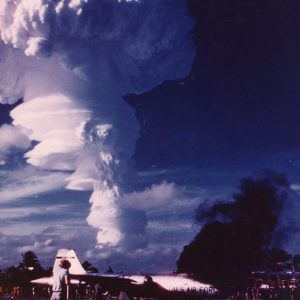calsfoundation@cals.org
Arkansas [Nuclear Test]
“Arkansas” was the code name for one of thirty-six nuclear tests conducted by the United States in the Pacific in 1962 as part of a program called Operation Dominic.
By 1958, the United States, Great Britain, and the Soviet Union (USSR) had established a tacit agreement toward a moratorium on testing nuclear weapons in the atmosphere. Following the failed Bay of Pigs invasion of Cuba, however, the Soviets announced on August 30, 1961, that they would resume atmospheric testing. U.S. president John F. Kennedy, following the first test by the USSR, announced on October 10, 1961, that the United States would also resume such tests.
To conduct the tests, the U.S. Joint Chiefs of Staff established Joint Task Force 8, which included military men from all branches of service and civilians from the Department of Defense, Atomic Energy Commission, and U.S. Public Health Service, as well as private-industry contractors. Task Force 8 was led by Major General Alfred D. Starbird, who had supervised previous nuclear tests, aided by scientific deputy William E. Ogle of the Los Alamos National Laboratory in New Mexico.
Operation Dominic tests were conducted between April and November 1962. The main goals of the nuclear blasts were to test new and existing nuclear weapon designs, determine the efficiency of airborne analysis of blast results, examine the effects of nuclear explosions on electromagnetic pulse phenomena, and analyze the effect a post-nuclear explosion environment would have on approaching ballistic missile warheads.
The test code-named “Arkansas” was to be conducted on April 29, 1962, but was postponed because of weather. Instead it was on May 2 that a B-52 bomber dropped a 1.09-megaton nuclear device near Christmas Island in the South Pacific at latitude 1.500000, longitude -157.277000 with the aim of determining the efficiency of the device for the Lawrence Livermore Laboratories. The nuclear weapon detonated at 5,030 feet, after which nine B-57s sampled the atmosphere between 40,000 and 62,000 feet.
Operation Dominic ultimately included five high-altitude tests near Johnston Island, twenty-nine air-drop airbursts near Johnston and Christmas Island (which included the “Arkansas” test), one airburst of a missile launched from a Polaris Missile, and one underwater test in the Pacific Ocean off the west coast of the United States. They ranged from a depth of 650 feet beneath the sea to 248 miles into the air, on the verge of outer space.
After the Cuban Missile Crisis brought the two superpowers to the brink of nuclear war in October 1962, they entered into formal negotiations and on August 5, 1963, representatives of the United States and the Soviet Union signed the Limited Test Ban Treaty at Moscow, effectively ending nuclear testing in the atmosphere, near outer space, and underwater—though not underground. The treaty became effective on October 10, 1963, and tests such as “Arkansas” would occur no more.
For additional information:
Boyne, Walter J. “Big Bang.” Air Force Magazine, December 2012. http://www.airforcemag.com/MagazineArchive/Pages/2012/December%202012/1212bang.aspx (accessed June 15, 2020).
Operation Dominic I. Defense Nuclear Agency, undated. Online at http://www.dtic.mil/dtic/tr/fulltext/u2/a136820.pdf (accessed June 15, 2020).
United States Nuclear Tests July 1945 through September 1992. Las Vegas: U.S. Department of Energy, National Nuclear Security Administration Nevada Field Office, September 2015. Online at https://www.nnss.gov/docs/docs_LibraryPublications/DOE_NV-209_Rev16.pdf (accessed June 15, 2020).
Mark K. Christ
Little Rock, Arkansas
 Divergent Prosperity and the Arc of Reform, 1968–2022
Divergent Prosperity and the Arc of Reform, 1968–2022 Military
Military Science and Technology
Science and Technology Operation Dominic
Operation Dominic 




Comments
No comments on this entry yet.